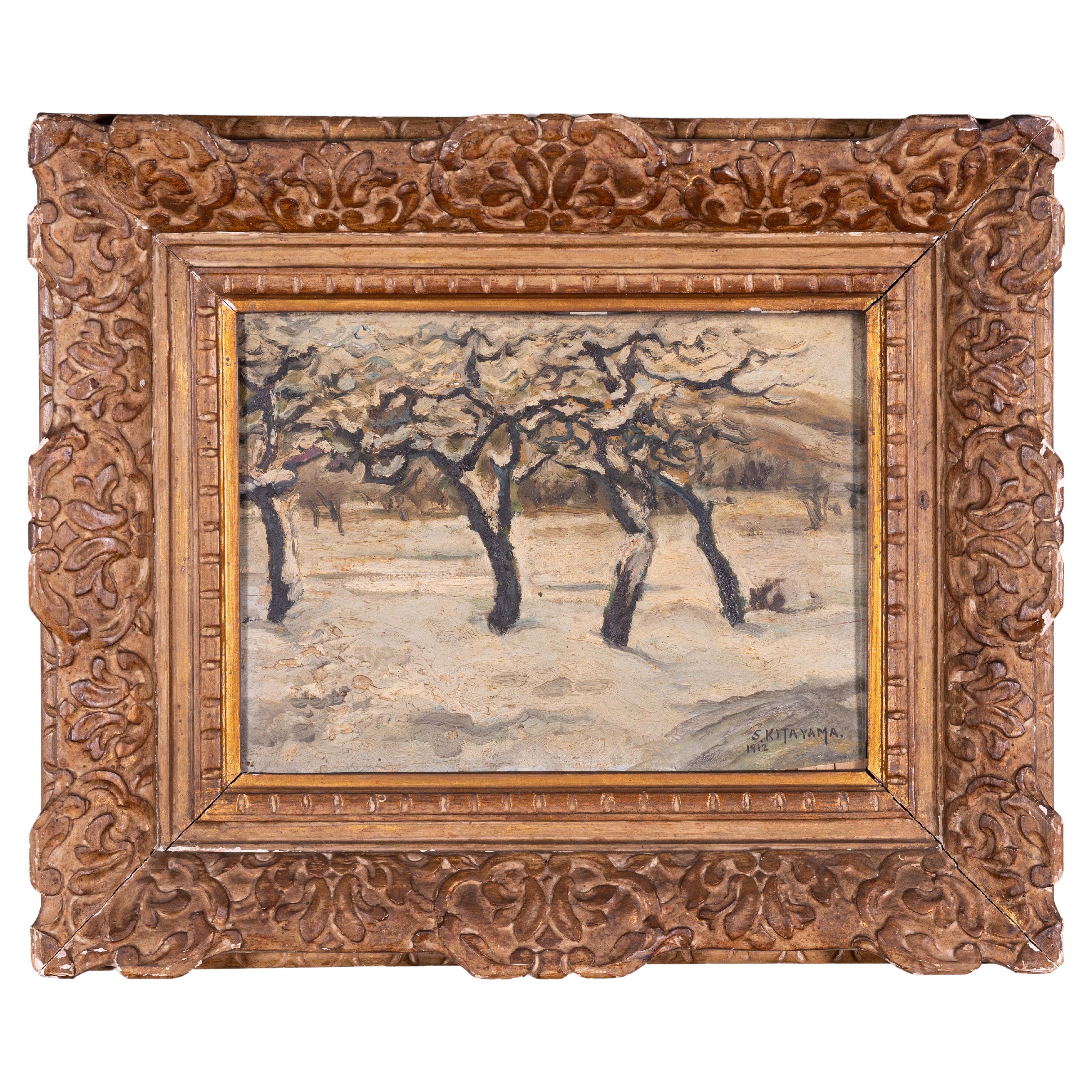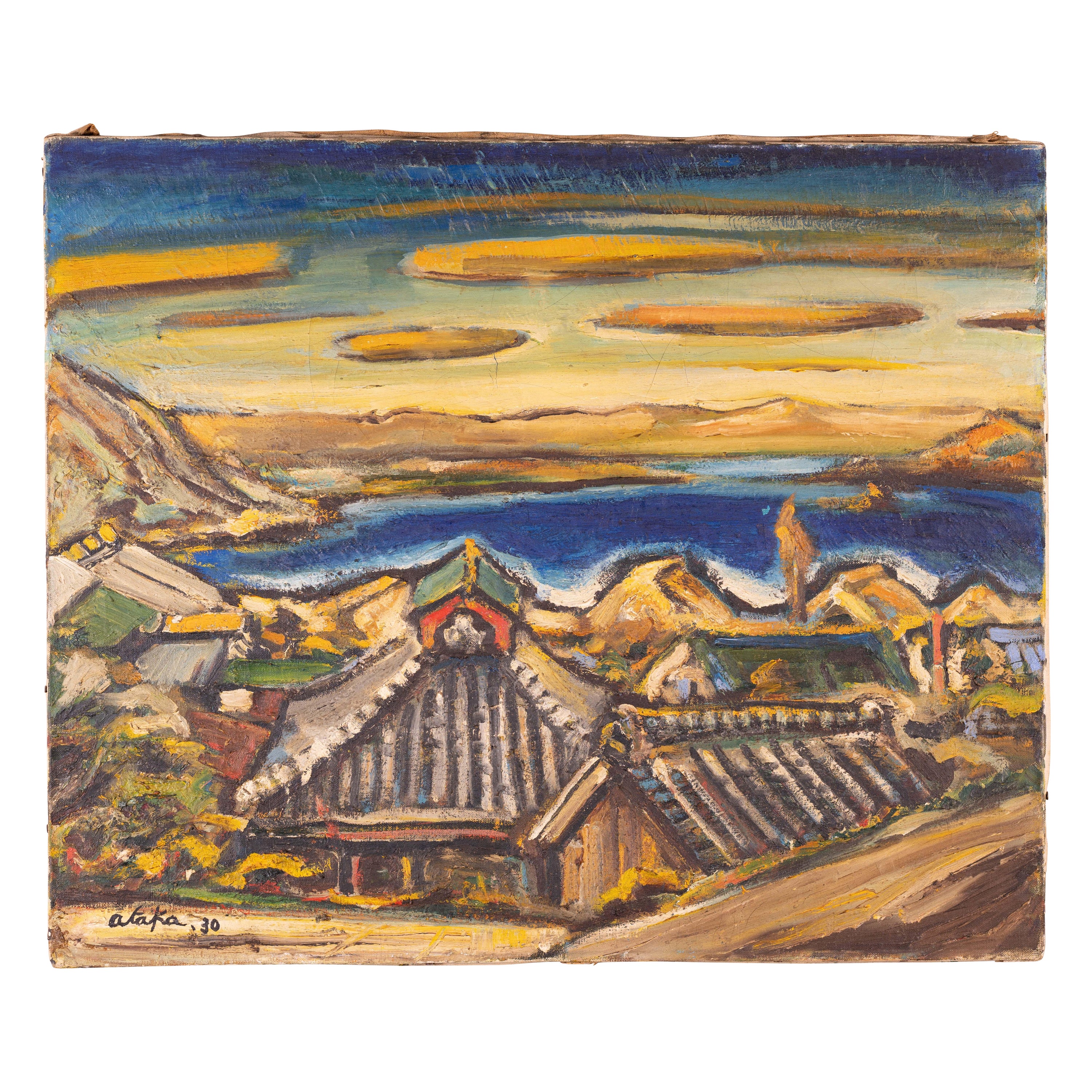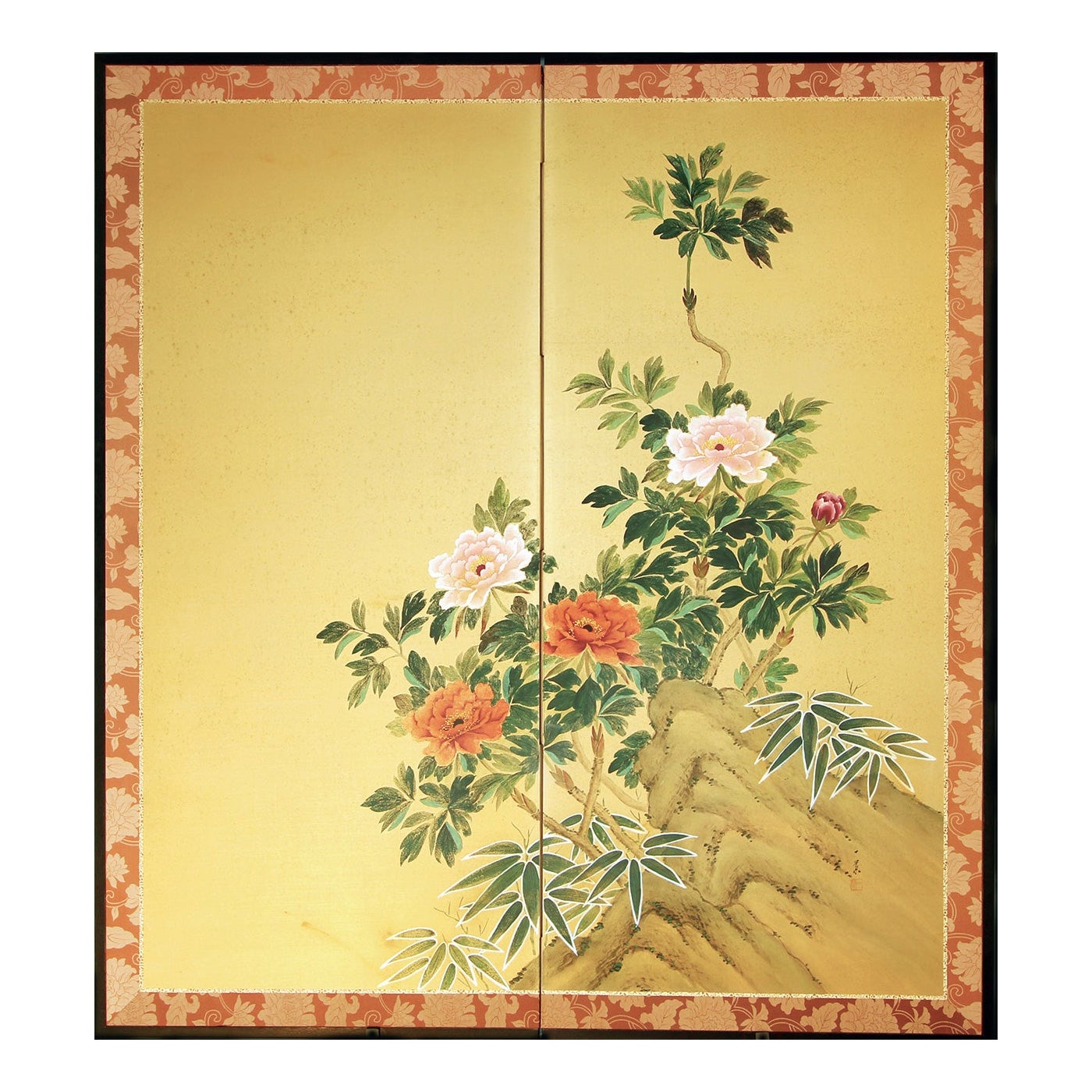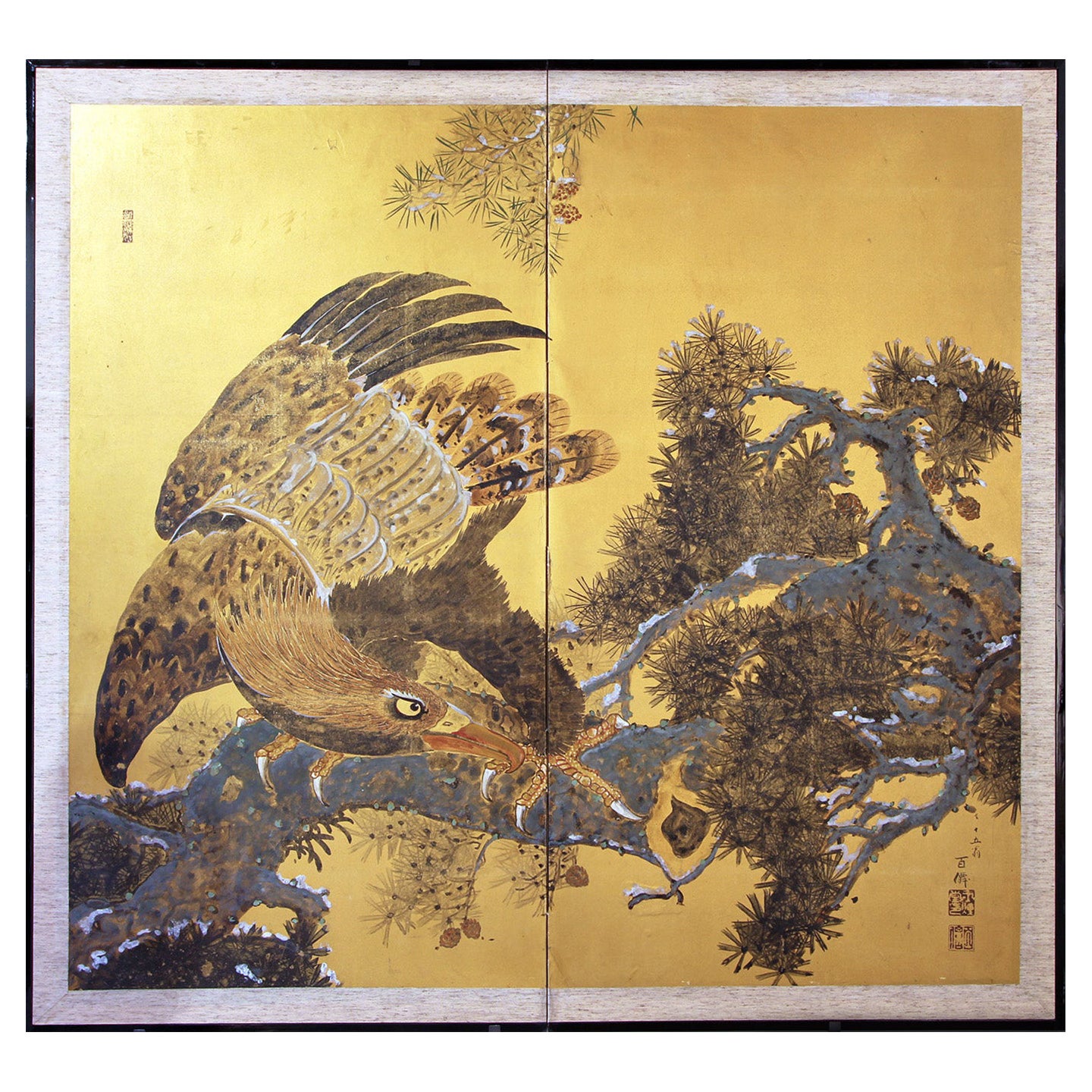Items Similar to Japanese Expressionist Painting of a Sea View from a Balcony by Yoshio Aoyama
Want more images or videos?
Request additional images or videos from the seller
1 of 5
Japanese Expressionist Painting of a Sea View from a Balcony by Yoshio Aoyama
About the Item
An expressionist oil painting of a seaside view from a balcony in carved gilded frame.
It is signed on the bottom right hand corner Aoyama.
Signed Aoyama circa 1960s-1970s
Frame measures 16 x 19 1/4 inches
Painting measures 9 1/2 x 13 inches
This painting is likely a scene from the French Riviera or Cote d'Azur.
Yoshio Aoyama (Japanese, 1894-1996).
He was a painter of nudes, landscapes, still-lifes, and flowers. Yoshio Aoyama started watercolor painting with the Japan Watercolorists Association. He went to France after World War I, where he studied with Matisse. He exhibited at the Salon d’Automne from 1921 to 1934 and the Salon des Indépendants from 1928 to 1930. Like Takanori Oguisu, he used a completely figurative Western technique to paint the French landscape.
Aoyama has a totally different style of painting than his Japanese predecessors like the painter Fujita, following a different path, because instead of introducing recognizable Japanese elements into his work, Aoyama chose to use them in a subtle way all along of her career. He never wanted to give up their tradition, yet Aoyama was able to adapt to Western culture by becoming an important part of the history of French painting of the twentieth century, forming part of the School of Paris .
One could say that in his painting there is an abstraction of a certain ideal transmitted by his ancestors, an ideal that manifests itself in the "joie de vivre" which is also present in painters like Pierre Bonnard , Raoul Dufy or his master Henri Matisse .
The School of Paris, located in the bohemian quarter of Montmartre, could be considered a real artistic tower of Babel, where mixed styles as diverse as Cubism, Modernism, Futurism, Primitivism etc. but with common features like fascination for the exotic, colorful. So Aoyama came into close contact with the European avant garde.
After his stay in Paris, he decided to move, for health reasons, to a warmer place, the capital of the French Riviera, Nice. Aoyama continued his painting, and it was at one of his exhibitions that he met Henri Matisse. Matisse, fascinated by his color, calmed calling Aoyama a marvelous colorist. Yoshio Aoyama became a disciple of the great French master. From 1926, his lessons with Matisse made a big change in the technique used. He began to create a new style full of originality, to recreate a fascinating and impressive world. Now, his figures will acquire the volume and the depth of the compositions. It gives them a sense of lyricism, poetry awash with a certain mystery that is still incomprehensible to the viewer. This change in Aoyama painting is being done gradually, in the precepts of Fauvism, leaving behind their Japanese tradition. Now, the colors pink and blue are a constant in his work. This step is still a step in forming a personal style.
Bibliography
Dictionary Bénézit , Critical and documentary dictionary of painters, sculptors, draughtsmen and engravers of all times and all countries , vol. 1, Gründ editions (es) Luis Pérez Nieto, Yoshio Aoyama. A painter of European inspiration.
- Creator:Japanese Studio (Painter)
- Dimensions:Height: 16 in (40.64 cm)Width: 19.25 in (48.9 cm)Depth: 2.5 in (6.35 cm)
- Style:Modern (In the Style Of)
- Materials and Techniques:
- Place of Origin:
- Period:
- Date of Manufacture:Circa 1970s
- Condition:
- Seller Location:San Francisco, CA
- Reference Number:1stDibs: LU7756232182572
About the Seller
5.0
Vetted Seller
These experienced sellers undergo a comprehensive evaluation by our team of in-house experts.
1stDibs seller since 2022
Typical response time: 5 hours
- ShippingRetrieving quote...Ships From: San Francisco, CA
- Return PolicyA return for this item may be initiated within 3 days of delivery.
More From This SellerView All
- Japanese Impressionist Painting of Trees in Snow By S Kitayama Dated 1912By Japanese StudioLocated in San Francisco, CAAn impressionist painting of a trees in snow on a wooden board in period carved gilded frame. It is signed on the bottom right hand corner S Kitayama and dated 1912. Further inscription in Kanji on the back of the frame. Frame measures 17 x 20 1/2 inches Painting measures 9 1/4 x 12 3/4 inches Frame is original to the painting and of the period. The painter is most likely Seitaro Kitayama (Japanese, 1888-1945), an important figure in late Meiji period credited with being the father of Japanese animation before Walt Disney started his company. The painting style is impressionism which was keenly followed by a new generation of Japanese artists who either traveled to Europe for training or received Western publications on artists and gallery shows at home. Kitayama, Seitaro was born on March 3, 1888 in Wakayama, and died on February 13, 1945. In 1911, Kitayama became an apprentice to Tojiro Oshita and, while studying painting, also helped out with editing the art magazine Mizue. He soon moved to Tokyo and established the Western Art Guild of Japan and published Contemporary Western Art. He later joined the Fusain Art Group as a manager where he would support young western-style artists such as Ryusei Kishida and Sohachi Kimura by providing art supplies, in addition to holding exhibitions and publishing catalogues. On the other hand, he entered the Nikkatsu Mukojima Studio in 1916, proposed the inclusion of illustrations in intertitles, and made this his work. It was there that one of the first Japanese animations...Category
Vintage 1910s Japanese Modern Paintings and Screens
MaterialsPaint, Acrylic
- Japanese Modernist Painting of a Seaside Village by Torao Ataka Dated 1930By Japanese StudioLocated in San Francisco, CAA Modern oil painting of a harbor town with the water and mountains views in the distance. It is signed on the bottom left hand corner Ataka and dated '30 (1930). The brushwork is ...Category
Vintage 1930s Japanese Modern Paintings and Screens
MaterialsCanvas, Paint
You May Also Like
- Japanese screenBy Japanese StudioLocated in Brescia, ITTwo-panel screen of Rinpa school painted with mineral pigments on silk and rice paper. It depicts colorful peony flowers. This is the flower of spring, symbolizing success and pro...Category
20th Century Japanese Showa Paintings and Screens
MaterialsSilk, Paper
- Six-Panel Japanese ScreenBy Japanese StudioLocated in Brescia, ITSix-panel screen of Rinpa school, painted with mineral pigments and gofun on vegetable paper and silver leaf.Category
Antique Early 19th Century Japanese Edo Paintings and Screens
MaterialsSilver Leaf
- Japanese screen two-panelBy Japanese StudioLocated in Brescia, ITEagle on a pine branch with traces of white snow. A rare subject for this mid-century two-panel screen, painted in mineral pigments on gilded paper. The screen is a nice size and is ...Category
20th Century Japanese Showa Paintings and Screens
MaterialsPaper
- Japanese Two Panel Screen Moon ViewingLocated in Hudson, NYJapanese two panel screen: Moon Viewing, painting of two noblewomen admiring the full moon outdoors. Extremely sophisticated execution of painting ove...Category
Vintage 1970s Japanese Showa Paintings and Screens
MaterialsSilk, Wood, Paper
- Edo Landscape Japanese Folding ScreenBy Japanese StudioLocated in Brescia, ITRefined work by a painter from the first half of the 19th century, from the landscape of the "Rinpa" school by a painter from the end of the 18th century, the Rinpa school. Six panels painted in ink on gold leaf and "gofun" on vegetable paper. The flowers are made with the "gofun" technique, natural or pigmented white oyster powder. Rinpa is one of the major historical schools of Japanese painting. The style was consolidated by the brothers Ogata Korin (1658–1716) and Ogata Kenzan (1663–1743). This folding screen has a very clean design that leaves plenty of room for the beautiful golden landscape. It comes flat and you can easily hang it with our hooks. Lucio Morini...Category
Antique 18th Century Japanese Edo Paintings and Screens
MaterialsGold Leaf
- Japanese Screen Painting of StallionsLocated in Hudson, NYJapanese two panel screen: Painting of stallions. Kano school of painting. Mineral pigments on mulberry paper.Category
Antique 19th Century Japanese Paintings and Screens
Recently Viewed
View AllMore Ways To Browse
From Japan
Japanese Used Furniture
Furniture In Japan
Japanes Vintage
Japanese Made
Japan Made
Made In Japan By
Japanese Furniture Modern
Japanese Modern
Japan Modern
Modern Japanese
Retro Japanese Furniture
Japanese Retro Furniture
Japan Flower
Japanese Flower
Japanese Style Furniture
Japanese Vintage Style
Japanese 20th Century Modern Furniture





